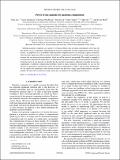Power of one qumode for quantum computation
Author(s)
Liu, Nana; Thompson, Jayne; Weedbrook, Christian; Lloyd, Seth; Vedral, Vlatko; Gu, Mile; Modi, Kavan; ... Show more Show less
DownloadPhysRevA.93.052304.pdf (217.2Kb)
PUBLISHER_POLICY
Publisher Policy
Article is made available in accordance with the publisher's policy and may be subject to US copyright law. Please refer to the publisher's site for terms of use.
Terms of use
Metadata
Show full item recordAbstract
Although quantum computers are capable of solving problems like factoring exponentially faster than the best-known classical algorithms, determining the resources responsible for their computational power remains unclear. An important class of problems where quantum computers possess an advantage is phase estimation, which includes applications like factoring. We introduce a computational model based on a single squeezed state resource that can perform phase estimation, which we call the power of one qumode. This model is inspired by an interesting computational model known as deterministic quantum computing with one quantum bit (DQC1). Using the power of one qumode, we identify that the amount of squeezing is sufficient to quantify the resource requirements of different computational problems based on phase estimation. In particular, we can use the amount of squeezing to quantitatively relate the resource requirements of DQC1 and factoring. Furthermore, we can connect the squeezing to other known resources like precision, energy, qudit dimensionality, and qubit number. We show the circumstances under which they can likewise be considered good resources.
Date issued
2016-05Department
Massachusetts Institute of Technology. Department of Mechanical Engineering; Massachusetts Institute of Technology. Research Laboratory of ElectronicsJournal
Physical Review A
Publisher
American Physical Society
Citation
Liu, Nana, Jayne Thompson, Christian Weedbrook, Seth Lloyd, Vlatko Vedral, Mile Gu, and Kavan Modi. “Power of One Qumode for Quantum Computation.” Physical Review A 93, no. 5 (May 3, 2016). © 2016 American Physical Society
Version: Final published version
ISSN
2469-9926
2469-9934